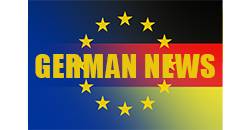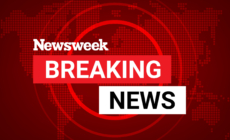-
Top Landing Spots For Von Miller Following Shocking Bills Release - 7 mins ago
-
Opinion | Musk’s Tweet-Fueled Bubble May Be About to Burst - 29 mins ago
-
Trump’s Putin Boost Like Hitler’s Final Deal: Top Historian - 42 mins ago
-
Secret Service Shoots Armed Man Near the White House - about 1 hour ago
-
Gen Z Man Has Revelation About Why His Parents Were ‘Always Tired’ - about 1 hour ago
-
Russian Forces Walk Inside Gas Pipeline to Out-Flank Ukrainian Troops - 2 hours ago
-
Syria’s Interim President Calls for Unity Amid Fresh Fighting - 2 hours ago
-
‘The stress keeps you up at night’: Emotional devastation lingers in L.A. fire zones - 2 hours ago
-
Weeks Old Puppy’s Eye Left ‘Hanging Out’ After Being Attacked by Mom - 2 hours ago
-
For California towns with bear problems, using dogs to hunt is no fix - 3 hours ago
How Canada and Mexico’s Leaders Took Different Routes to a Tariff Deal With Trump
Prime Minister Justin Trudeau of Canada went for a threat of immediate retaliation and a late-night emotional address that produced a cliffhanger compromise.
President Claudia Sheinbaum of Mexico opted for carrots over sticks, and backroom talks that led to an early deal.
In the end, when all was said and done on Monday, hours before what would have been the start of a North American trade war, both leaders negotiated reprieves from President Trump on his threat to impose tariffs on the United States’ two top trading partners.
And both had to provide relatively little in exchange.
The different routes Mr. Trudeau and Ms. Sheinbaum followed to the same outcome — a 30-day delay in U.S. tariffs in exchange for toughening their borders to stem the flow of drugs and unauthorized migrants into the United States — tell a tale of two different styles of leadership, and two countries with different relationships to the United States.
Mr. Trudeau had been preparing the ground for compromise — and retaliation — since November. Three days after Mr. Trump first issued his tariff threat on Nov. 25, the Canadian prime minister got on a plane to Mar-a-Lago to talk to him about averting what would amount to a fraternal trade war that would deeply hurt the Canadian economy.
By all accounts, that first meeting set the scene for Canada’s groundwork to directly address what Mr. Trump said he wanted: a safer northern border, with fewer unauthorized migrant crossings, and a tighter grip on fentanyl flowing across the border.
The parallel story of how Mexico’s leader got the same tariff delay for her country, with a few hours’ advantage over Canada, highlights Ms. Sheinbaum’s firm and composed leadership style, and her willingness to focus on partnership in her talks with Mr. Trump.
Even before being voted into office in June, Ms. Sheinbaum and her team had been preparing for the possibility that Mr. Trump would return to the White House. And since his victory in November, Ms. Sheinbaum has reiterated that she wasn’t concerned despite his threats of mass deportations and tariffs. The day after the U.S. elections, she promised to “establish communication and good relations.”
In Canada, the weeks since the meeting at Mar-a-Lago between Mr. Trudeau and Mr. Trump have been packed with developments that normally take months, or even years, to unfold. For starters, Mr. Trudeau, who has become increasingly unpopular at home, announced that he would resign. On March 9 his party, the Liberals, will elect a new leader and that person will become Canada’s next prime minister, at least until a federal election is called later this year.
Several of his top ministers said they would not run to replace him in order to focus on the looming tariff showdown. The foreign minister, Mélanie Joly, and the finance minister, Dominic LeBlanc, both close Trudeau allies and potential successors, instead threw themselves at lobbying key Republicans.
Mr. LeBlanc developed a “bromance” with Howard Lutnick, Mr. Trump’s pick to be commerce secretary. Ms. Joly visited the United States five times, lobbying senior Republicans and talking to Mr. Trump’s border czar, Thomas Homan.
She told them that Canada would take the lead in protecting the border so that the United States would not need to use too many resources.
“I said, we know that the southern border is a preoccupation for you, so we will put the resources at the northern border,” Ms. Joly said in an interview about her message to Republicans she met. “That way you can have your resources at the southern border.”
But Mr. Trudeau also made it clear that he would level retaliatory tariffs against the United States if Mr. Trump decided to go ahead with his threat. Government officials said that the outgoing Canadian leader believed it was vital to stand up for Canada in a more aggressive way, while simultaneously working to satisfy Mr. Trump’s demands.
Canada in December rolled out, and budgeted for, a multiyear $900 million plan to bolster its border protections. That included immediately deploying two Blackhawk helicopters, 60 U.S.-made drones and additional border guards.
On Saturday, after the White House had announced that Mr. Trump would go ahead with the tariffs, Mr. Trudeau addressed not just Canadians, but also made clear he was speaking directly to Americans, in an emotional late-night speech.
“We don’t want to be here,” Mr. Trudeau said, evoking the deep bonds between the two neighbors and close trading partners. “We didn’t ask for this.”
But, as he detailed his own retaliatory tariff plan, he added: “We will stand strong for Canada.”
In the end, it came down to the wire. Mr. Trudeau and Mr. Trump failed to reach a compromise in a Monday morning call. That prolonged the anxiety for a few hours, but, a second call in the late afternoon yielded a deal, with Mr. Trump agreeing to push tariffs back by a month.
The foundations of the eventual deal announced on Monday afternoon had been in place for weeks, but Canada also pledged to do more on the fentanyl front, appointing a “fentanyl czar” and committing fresh resources to combating organized crime and cartels.
In Mexico, Ms. Sheinbaum’s predecessor and mentor, Andrés Manuel López Obrador, had forged a close working relationship with Mr. Trump in the early years of his administration, despite similar circumstances: Mr. Trump’s repeated threats to impose tariffs on Mexico and make the country pay for a border wall. In an effort to stave off levies, Mr. Lopez Obrador agreed to bolster immigration enforcement, including deploying the National Guard.
Conditions, though, have changed since then. Mexico has eclipsed China as the largest trading partner in goods with the United States. And Mexico emerged as the top market worldwide for U.S. food and agriculture exports, with those imports surging to more than $29 billion.
But there is a key difference between Mr. López Obrador and Ms. Sheinbaum: While he at times adopted a confrontational tone toward the United States, she maintains a more measured and coolheaded demeanor.
Unlike Canada, which was clear both about its plans to retaliate with its own tariffs on U.S. goods and with its border plans to address Mr. Trump’s demands, Ms. Sheinbaum and her team were more tight-lipped.
After Mr. Trump ordered the tariffs on Saturday, Ms. Sheinbaum still bided her time, promising to reveal her “Plan B” response later — but she first asked that Mr. Trump respond to her request to form a working group of security and health officials from both countries.
Later that Saturday, Mr. Trudeau and Ms. Sheinbaum got on the phone to swap notes. A Canadian official with knowledge of the call said that they updated each other on their respective strategies, and acknowledged that they were slightly different approaches, but had the exact same goals.
On Monday morning, Ms Sheinbaum and Mr. Trump spoke on the phone, a call that yielded a faster outcome than the one Mr. Trump held with Mr. Trudeau. Shortly after, Ms. Sheinbaum posted on X that a compromise had been reached.
Addressing reporters later, Ms. Sheinbaum said the discussion had been “very respectful.” Mr. Trump described the call as “very friendly.”
She, too, secured a 30-day reprieve for Mexico in exchange for border and fentanyl measures, most of which, like in the case of Canada, had been part of existing plans.
“We have this month to work, to convince each other that this is the best way forward,” Ms. Sheinbaum said at her regular morning news conference after speaking to President Trump. Suggesting that she might be able hold off the penalties altogether, she said she had told her American counterpart: “We are going to deliver results. Good results for your people, good results for the Mexican people.”
As for Mr. Trudeau, when the 30-day reprieve lapses, he will be in his last week in office.




















